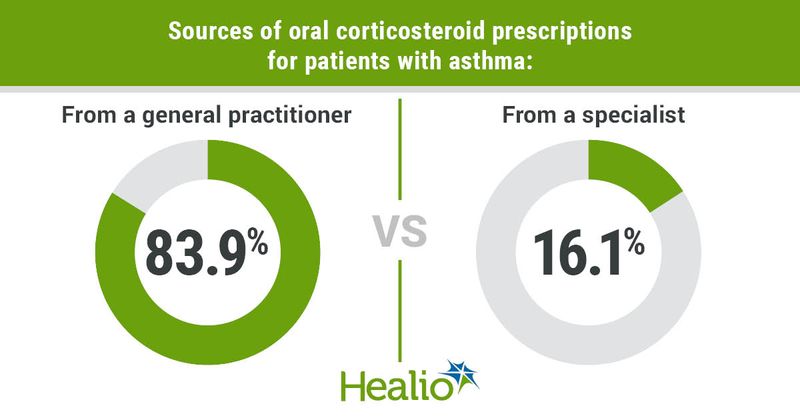Oral corticosteroid overuse ‘often overlooked’ among patients with asthma
Patients with asthma appeared overexposed to oral corticosteroids, potentially putting them at risk for long-term side effects, according to a study published in The Journal of Allergy and Clinical Immunology: In Practice.
New protocols and better education could reduce these risks and improve care, Akke-Nynke van der Meer, MD, pulmonologist in the department of medicine at Medical Centre Leeuwarden in the Netherlands, and colleagues wrote.

Further, the researchers noted growing evidence of the risks for cumulative lifetime exposure to oral corticosteroids (OCS) and the potential benefits of new monoclonal antibodies targeting type 2 inflammation as alternatives.
The researchers analyzed March 2017 to March 2018 records from IQVIA Longitudinal Prescription Data, which covers approximately 75% of all prescriptions dispensed in the Netherlands.
The 182,849 adults (median age, 51 years; interquartile range [IQR], 39-66; 59.4% women) in the study received two or more prescriptions for inhaled corticosteroids (ICS) for at least 4 months of therapy. Most patients (75.6%) were treated with medium (> 250-500 g fluticasone equivalent) to high (> 500 µg fluticasone equivalent) doses of ICS.
Also, 22.2% had received at least one OCS prescription during the study period, with 4.6% classified as maintenance OCS users who had a median daily dose of 10 mg (IQR, 7.3-12.9 mg) of a prednisolone equivalent and 17.6% classified as course-only patients receiving a median of one (range, 1-7) OCS course.
Of note, 83.9% of these patients did not receive their prescriptions from a specialist. Of the 16.1% who did, 94.1% came from a pulmonologist, 4.8% from an ear/nose/throat physician and 1.2% from an allergist.
Overall, 7.2% of patients with asthma had received two or more courses of OCS therapy (2.6%) or maintenance OCS (4.6%) therapy during the study period, which the researchers called overexposure.
Researchers identified high doses of ICS during the study period among more than half of patients who had two or more courses of OCS therapy (53.9%) and those on maintenance OCS therapy (54.4%), with 51.1% of the two or more OCS course group and 34.3% of the maintenance group not receiving a prescription from a specialist within the prior 3 years.
The patients receiving maintenance OCS therapy had a higher cumulative OCS dose (median prednisolone equivalent/person, 760 mg; IQR, 450-1,680) compared with the group with two or more OCS courses (median, 400 mg; IQR, 300-449 mg) and those with one course (median, 210 mg; IQR, 150-210 mg).
Only 4.6% of all patients in the study used maintenance OCS therapy, but they accounted for 56.8% of the total OCS exposure on a population level, whereas those receiving one OCS course made up 32.6% and those receiving two or more comprised 10.6% of the population’s total OCS exposure during the study period.
Overall, the researchers wrote, a general practitioner prescribed OCS without specialist supervision to 57% or more of patients who frequently used it during the study period, although they added that specialists seem to prescribe these drugs too frequently as well.
Highlighting the need to pay more attention to exacerbation management, the researchers described OCS overuse as “often overlooked and inadequately addressed” and they called for the identification of patients with uncontrolled asthma regardless of where they are managed due to their risks for OCS toxicity.
They also cited biologics that effectively target type 2 inflammation and significantly reduce exacerbations as well as OCS courses and their potential side effects, noting how global guidelines recommend short OCS courses for asthma exacerbations and low-dose OCS maintenance only for patients with uncontrolled asthma whose biologics treatment has failed.
With these findings, the researchers called for awareness and understanding of OCS burdens among general practitioners and specialists. Patients should be educated, involved and empowered in their treatment as well, the researchers continued.
Finally, the researchers wrote, new workup and therapy adjustment protocols could be effective in reducing the OCS burden among patients with asthma.
